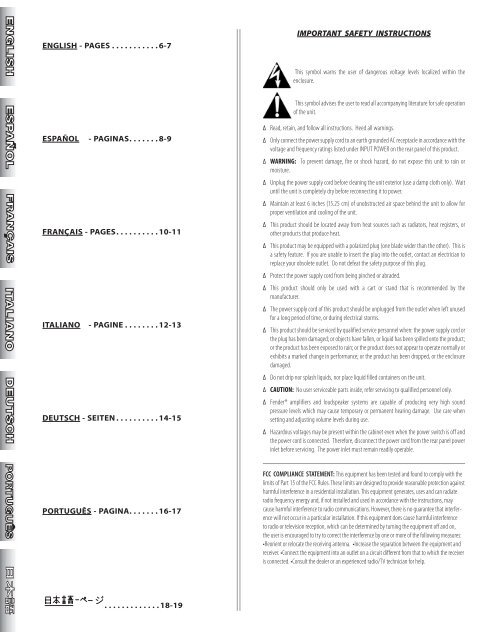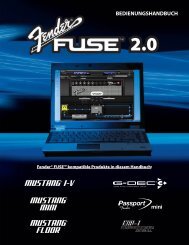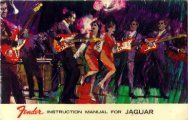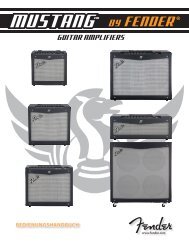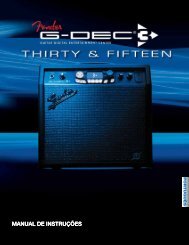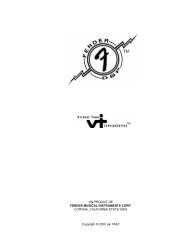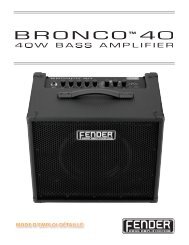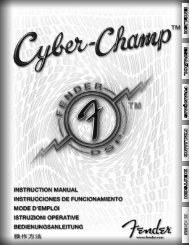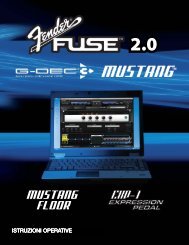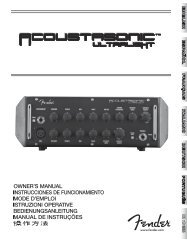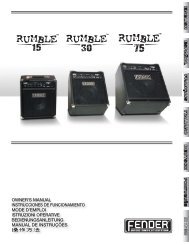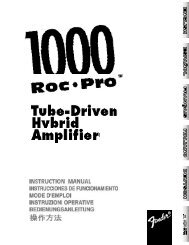Fender® Guitar
Fender® Guitar
Fender® Guitar
You also want an ePaper? Increase the reach of your titles
YUMPU automatically turns print PDFs into web optimized ePapers that Google loves.
ENGLISH - PAGES . . . . . . . . . . . 6-7<br />
ESPAÑOL - PAGINAS . . . . . . . 8-9<br />
FRANÇAIS - PAGES . . . . . . . . . . 10-11<br />
ITALIANO - PAGINE . . . . . . . . 12-13<br />
DEUTSCH - SEITEN . . . . . . . . . . 14-15<br />
PORTUGUÊS - PAGINA . . . . . . . 16-17<br />
. . . . . . . . . . . . . 18-19<br />
Important Safety InStructIonS<br />
This symbol warns the user of dangerous voltage levels localized within the<br />
enclosure.<br />
This symbol advises the user to read all accompanying literature for safe operation<br />
of the unit.<br />
∆ Read, retain, and follow all instructions. Heed all warnings.<br />
∆ Only connect the power supply cord to an earth grounded AC receptacle in accordance with the<br />
voltage and frequency ratings listed under INPUT POWER on the rear panel of this product.<br />
∆ WARNING: To prevent damage, fire or shock hazard, do not expose this unit to rain or<br />
moisture.<br />
∆ Unplug the power supply cord before cleaning the unit exterior (use a damp cloth only). Wait<br />
until the unit is completely dry before reconnecting it to power.<br />
∆ Maintain at least 6 inches (15.25 cm) of unobstructed air space behind the unit to allow for<br />
proper ventilation and cooling of the unit.<br />
∆ This product should be located away from heat sources such as radiators, heat registers, or<br />
other products that produce heat.<br />
∆ This product may be equipped with a polarized plug (one blade wider than the other). This is<br />
a safety feature. If you are unable to insert the plug into the outlet, contact an electrician to<br />
replace your obsolete outlet. Do not defeat the safety purpose of this plug.<br />
∆ Protect the power supply cord from being pinched or abraded.<br />
∆ This product should only be used with a cart or stand that is recommended by the<br />
manufacturer.<br />
∆ The power supply cord of this product should be unplugged from the outlet when left unused<br />
for a long period of time, or during electrical storms.<br />
∆ This product should be serviced by qualified service personnel when: the power supply cord or<br />
the plug has been damaged; or objects have fallen, or liquid has been spilled onto the product;<br />
or the product has been exposed to rain; or the product does not appear to operate normally or<br />
exhibits a marked change in performance; or the product has been dropped, or the enclosure<br />
damaged.<br />
∆ Do not drip nor splash liquids, nor place liquid filled containers on the unit.<br />
∆ CAUTION: No user serviceable parts inside, refer servicing to qualified personnel only.<br />
∆ <strong>Fender®</strong> amplifiers and loudspeaker systems are capable of producing very high sound<br />
pressure levels which may cause temporary or permanent hearing damage. Use care when<br />
setting and adjusting volume levels during use.<br />
∆ Hazardous voltages may be present within the cabinet even when the power switch is off and<br />
the power cord is connected. Therefore, disconnect the power cord from the rear panel power<br />
inlet before servicing. The power inlet must remain readily operable.<br />
FCC COMPLIANCE STATEMENT: This equipment has been tested and found to comply with the<br />
limits of Part 15 of the FCC Rules. These limits are designed to provide reasonable protection against<br />
harmful interference in a residential installation. This equipment generates, uses and can radiate<br />
radio frequency energy and, if not installed and used in accordance with the instructions, may<br />
cause harmful interference to radio communications. However, there is no guarantee that interference<br />
will not occur in a particular installation. If this equipment does cause harmful interference<br />
to radio or television reception, which can be determined by turning the equipment off and on,<br />
the user is encouraged to try to correct the interference by one or more of the following measures:<br />
•Reorient or relocate the receiving antenna. •Increase the separation between the equipment and<br />
receiver. •Connect the equipment into an outlet on a circuit different from that to which the receiver<br />
is connected. •Consult the dealer or an experienced radio/TV technician for help.


